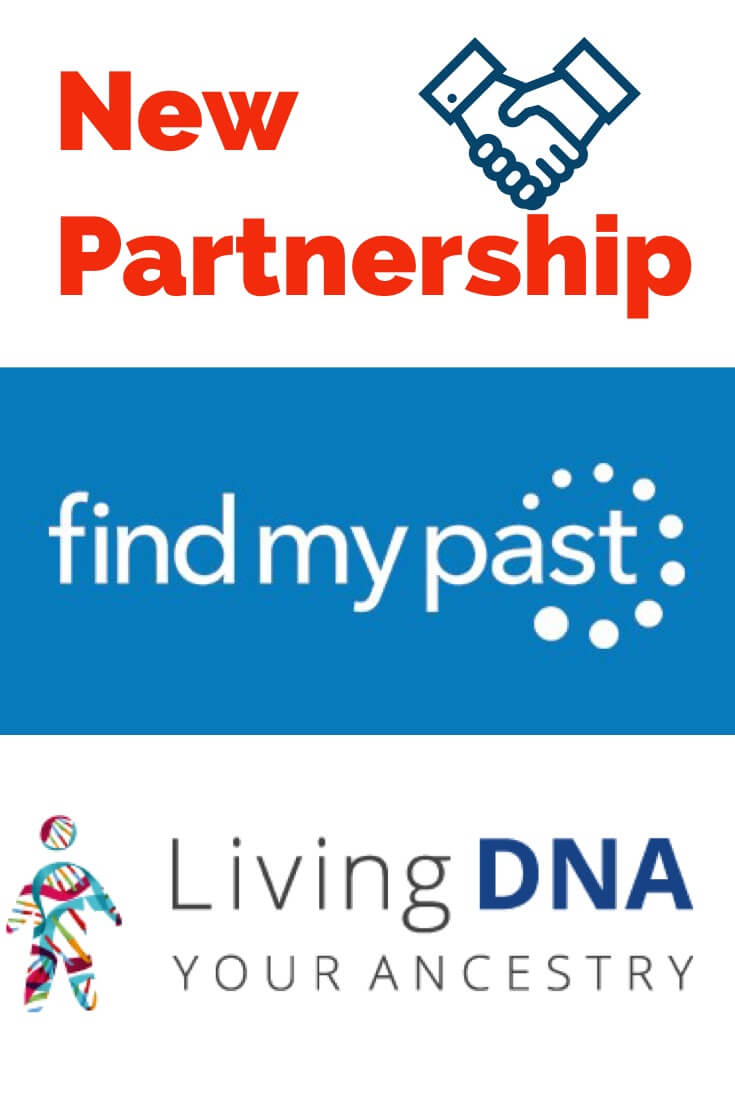by Lacey Cooke | Dec 3, 2018 | 01 What's New, Ancestry, DNA |
Get a new perspective on your DNA results with AncestryDNA’s new Genetic Traits feature. For just $10, you can discover how traits run in your family and might even come from ethnic origins, with no additional DNA test needed. It’s a deeper look into what makes you YOU, and it’s a fantastic way to engage non-genealogists in your family to be interested in where they come from.
Share Traits This Holiday Season
While the new Genetic Traits feature from AncestryDNA may not be directly applicable to genealogical research or uncovering brick wall ancestors, it’s the ideal tool to interest the non-genealogist in your family. Your relatives might not be interested in cousin-matching and identifying shared ancestors, but they will love discovering what makes them unique. The Genetic Traits tool provides another vehicle for people to discover their origins and connect with their past in a meaningful way. If you’re giving a DNA test kit as a gift this year, consider gifting the Traits feature as well. And have fun exploring your own traits! Order now at Ancestry.com or on Amazon.
New AncestryDNA Feature: Genetic Traits
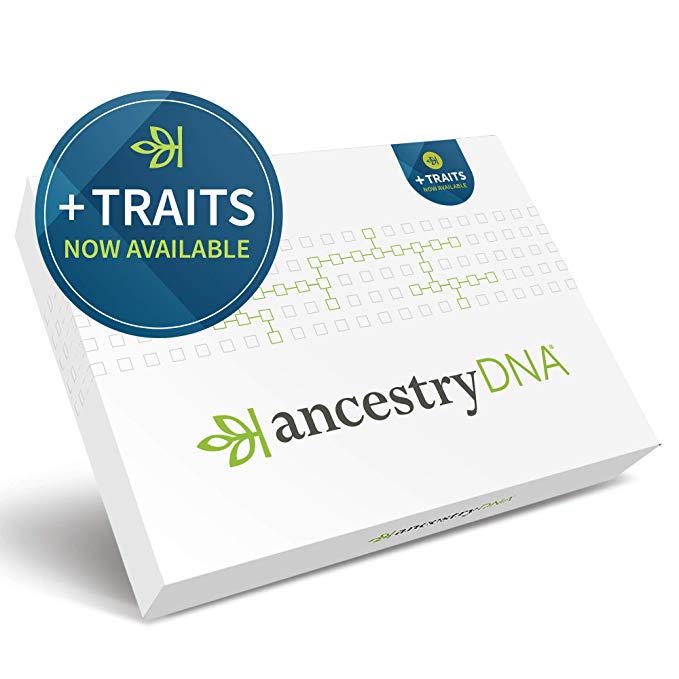
November 9, 2018: “Ancestry’s long history of innovation has driven our leadership in family history and, more recently, the emerging field of consumer genomics. Today, we’re proud to introduce a fun and innovative way for you to further explore who you are and where you come from – AncestryDNA Traits. Using science and data to power ongoing journeys of discovery, Traits is a new interactive experience that allows you to discover traits and attributes influenced by your DNA. With AncestryDNA Traits, you can explore up to 18 traits and attributes that you’ve inherited from your ancestors, share with family, and may pass down to future generations.”
Through AncestryDNA Traits, people can:
- Identify 18 traits (full list below)
- Compare your genetic markers to your matches via the AncestryDNA mobile app to see who in your family you share certain traits with.
- Explore an “Around the World” interactive map, where you can see how your traits align with your heritage.
- New customers can upgrade their AncestryDNA kit to include Traits for an additional $10.00 on Ancestry.com and Amazon. Existing customers can purchase the Traits feature for $10.00 through their Ancestry account.
Identifiable Traits
With AncestryDNA Traits, customers can explore up to 18 traits and attributes including:
- Finger length
- Cleft chin
- Earlobe type
- Earwax type
- Eye color
- Freckles
- Hair color
- Hair type
- Hair strand thickness
- Iris patterns
- Male hair loss
- Skin pigmentation
- Unibrow
- Bitter taste perception
- Sweet taste perception
- Savory taste perception
- Asparagus metabolite detection
- Cilantro aversion
More About Traits
From Ancestry: “Powered by AncestryDNA, Traits gives you an even deeper look at your personal story through the “Around the World” interactive map. You can explore how your traits align with your heritage and learn whether your green eyes are common in other people with Irish ancestry.
Those of you with the AncestryDNA Mobile app will be the first with access to our new Traits Compare feature which allows you to compare your genetic markers that influence your traits with friends, family, or any other AncestryDNA customer who has Traits.
Traits is just the latest example of the many tools we’re working on to enable a journey of personal discovery that we hope will enrich your life. As in everything we do, protecting your privacy is our highest priority, so we will continue to place you in control of your data – that means both you and your counterpart must consent to participate in any Traits Comparison.”
Lacey has been working with Genealogy Gems since the company’s inception in 2007. Now, as the full-time manager of Genealogy Gems, she creates the free weekly newsletter, writes blogs, coordinates live events, and collaborates on new product development. No stranger to working with dead people, Lacey holds a degree in Forensic Anthropology, and is passionate about criminal justice and investigative techniques. She is the proud dog mom of Renly the corgi.
Disclosure: This article contains affiliate links and Genealogy Gems will be compensated if you make a purchase after clicking on these links (at no additional cost to you). Thank you for supporting Genealogy Gems!
by Sunny | Nov 29, 2018 | 01 What's New, DNA
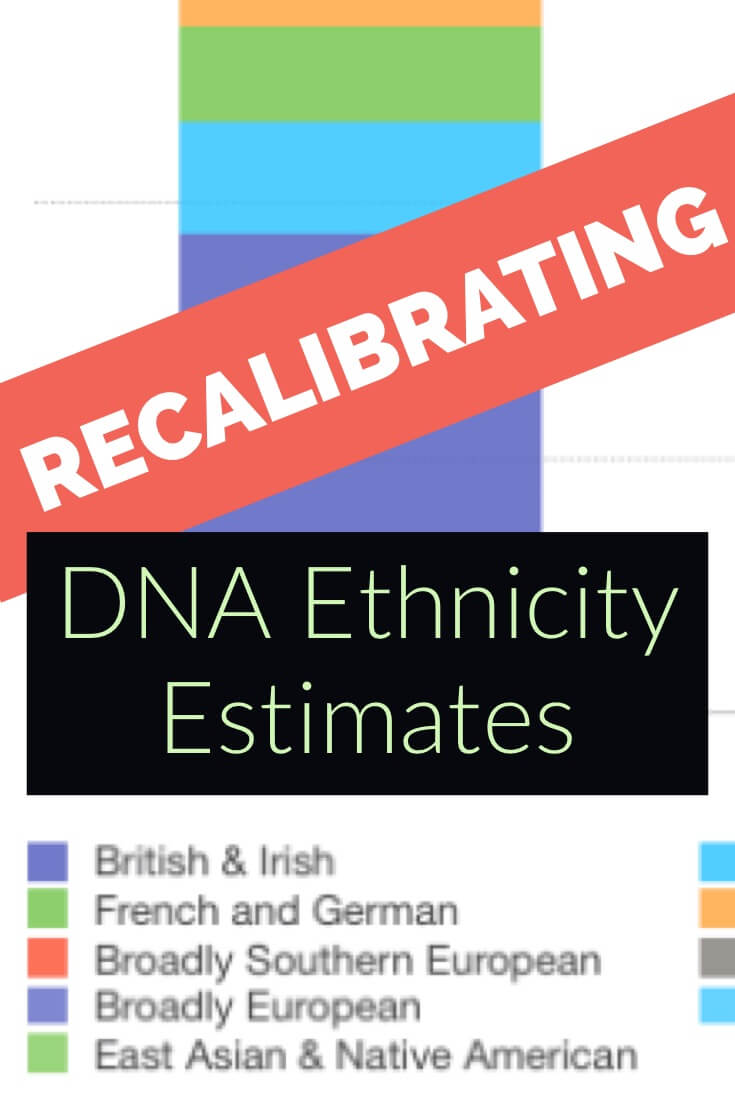 Genealogy testing companies have been hard at work recalibrating your ethnicity calculations based on new and better data. Here’s the latest from Your DNA Guide Diahan Southard.
Genealogy testing companies have been hard at work recalibrating your ethnicity calculations based on new and better data. Here’s the latest from Your DNA Guide Diahan Southard.
Family History DNA Pie Charts and Percentages
Remember that the pretty pie charts and percentages are based on fancy math and reference populations. The initial reference populations released by our testing companies were a great start, but many categories lacked sufficiently high numbers of people to represent all of the facets of a population. In the 10+ years since their release, many updates have been made. But the fancy math that is used to produce our percentages can only be as fancy as the numbers you give it. The numbers have been hard at work at Family Tree DNA, AncestryDNA and 23andMe in the past couple of months with the result being a major overhaul in the way our ethnicity results are reported.
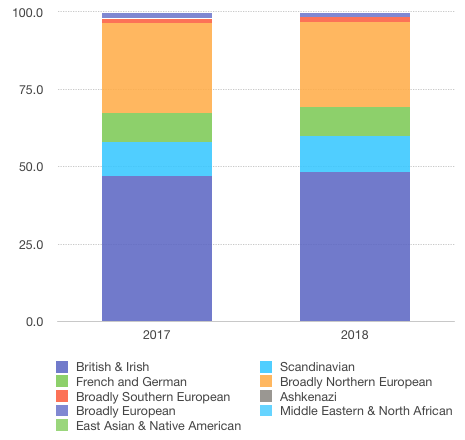
Image 1
23andMe
We recently reported about the update at 23andMe and their increase from 31 reference populations to 150. However, for me, the totally 100% European me, there wasn’t much excitement. As you can see in the 23andMe chart, I had a couple of numbers move up or down slightly, but not anything to write home about. However, I am certain those with South American, or Eastern European ancestry have a much different story. 23andMe added many new reference populations to better represent these underrepresented areas of the world, a move which has likely made a big difference for the ever diversifying pool of individuals who have taken a DNA test.
AncestryDNA
AncestryDNA also released their latest Ethnicity update in September, boasting an additional 13,000 reference samples to their database. They not only upgraded their numbers, but also shifted some of their categories around based on this new data. They seem to not be quite sure what to do with Ireland, as in early 2017 it was its own category, later moving in with Wales and Scotland, and now appears in this latest update as simply Ireland and Scotland. My previous numbers from AncestryDNA seemed to at least loosely reflect my heritage (meaning that I do actually have people in my genealogy chart from a few of these places).
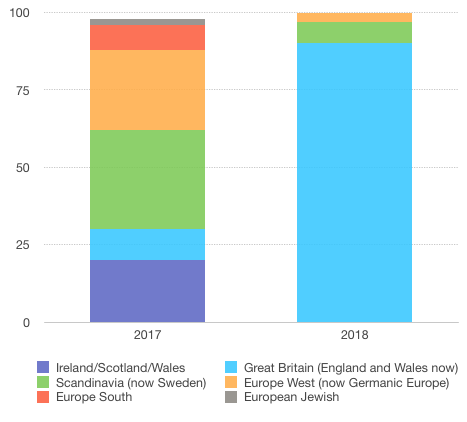
Image 2
But the new DNA numbers? Big Changes.
I have one set of great grandparents from Germany, but it looks like nearly all my German was sucked into England, but miraculously, they seemed to have precisely found my Swedish 2X great grandmother, with the 7% that I should have from that area.
With the new update, though I am sad to see my German go, AncestryDNA is now more fully in line with the results I have received from 23andMe, LivingDNA, and MyHeritage, all of which put my England/British Isles count up around 90%. If I compare my results from various companies and combine any subcategories into one England/British Isles category, indicate Scandinavian, and then lump everything else together, the results from the four companies are actually quite similar (I don’t have my own results at Family Tree DNA, only my parents).
My Family History DNA Results
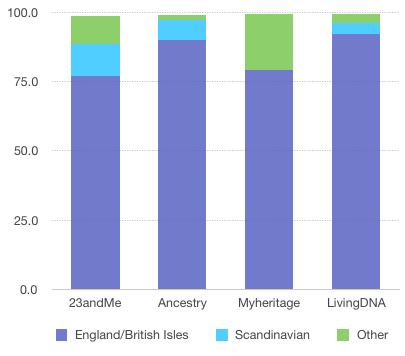
Image 3
Here’s how my results currently stack up at each of these websites. (Image 3)
Which DNA Testing Company to Choose
So which company is the best at all of this? Well, I usually say that if you test everywhere, your “true” answer is likely somewhere in the middle. But really, you can determine which company is best for you by examining their reference populations, and determining which company is most likely able to meet your goals.
In the end, it is always good to remember two things:
- Your DNA does not fully represent your family history, so your ethnicity results can’t possibly tell you everything about your heritage.
- This technology is purposefully titled as an estimate. So be sure you treat it that way.
Learn More about Genetic Genealogy
Recommended reading at Genealogy Gems: Understanding DNA Ethnicity Estimates
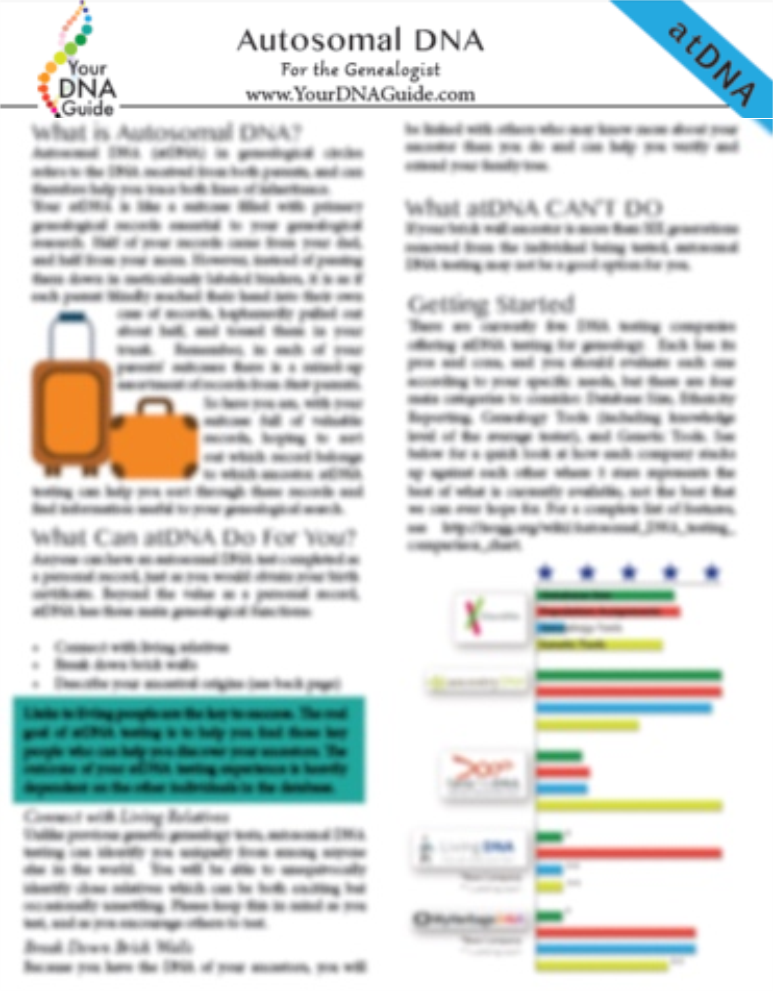
Get Diahan’s quick reference guides including Autosomal DNA for the Genealogist at the Genealogy Gems store.
by Lacey Cooke | Nov 17, 2018 | 01 What's New, DNA, MyHeritage |
A brand new DNA test feature has just been launched at MyHeritage: the display of Shared Ancestral Places. This intriguing feature will arm you with more information to identify common ancestors and unlock mysteries in your family tree. Learn more about using this new tool and applying it to your DNA brick walls.
Shared Ancestral Places
DNA Matching is the core of any genetic genealogy testing service. But sometimes matches leave you with more questions than answers, or simply don’t have enough information for further investigation. MyHeritage DNA is tackling that very problem with their brand new feature: Shared Ancestral Places.
From their recent announcement, “When you review a DNA Match, it’s not always clear how the match is related to you and who your common ancestor may be. Up until now, you may have been able to figure out how your DNA Matches are related to you by looking at the family trees of your matches, the Shared Ancestral Surnames, or Smart Matches™ that exist between your trees. As of this week, if you and a DNA Match have a Shared Ancestral Place, you will be armed with more information to investigate the match further. You may be able to determine which common ancestor you and your match share from whom you both inherited the same DNA segments.”
What are Shared Ancestral Places?
As described by MyHeritage, “Shared Ancestral Places refer to towns, countries, or U.S. states that appear in your family tree as well as in the family trees of your DNA Matches, where birth or death events of your ancestors (and those of your DNA Matches’ ancestors) took place. These places are identified going back up to 10 generations and can play a vital role in family history research.”
When you receive a match and it is unclear what common ancestor you share, having a Shared Ancestral Place can be a wonderful clue that you are indeed related. Having shared origins, whether in a large city or small village, provides evidence of connection and can aid you in pursuing your match further.
Accessing Shared Ancestral Places
To see your Shared Ancestral Places with any of your DNA matches (when they exist), head to your DNA Matches page. To view extended information about any of the common ancestral places, move the mouse over it. A tooltip will open with additional details. There you’ll see how many Shared Ancestral Places you have in common with this DNA Match.
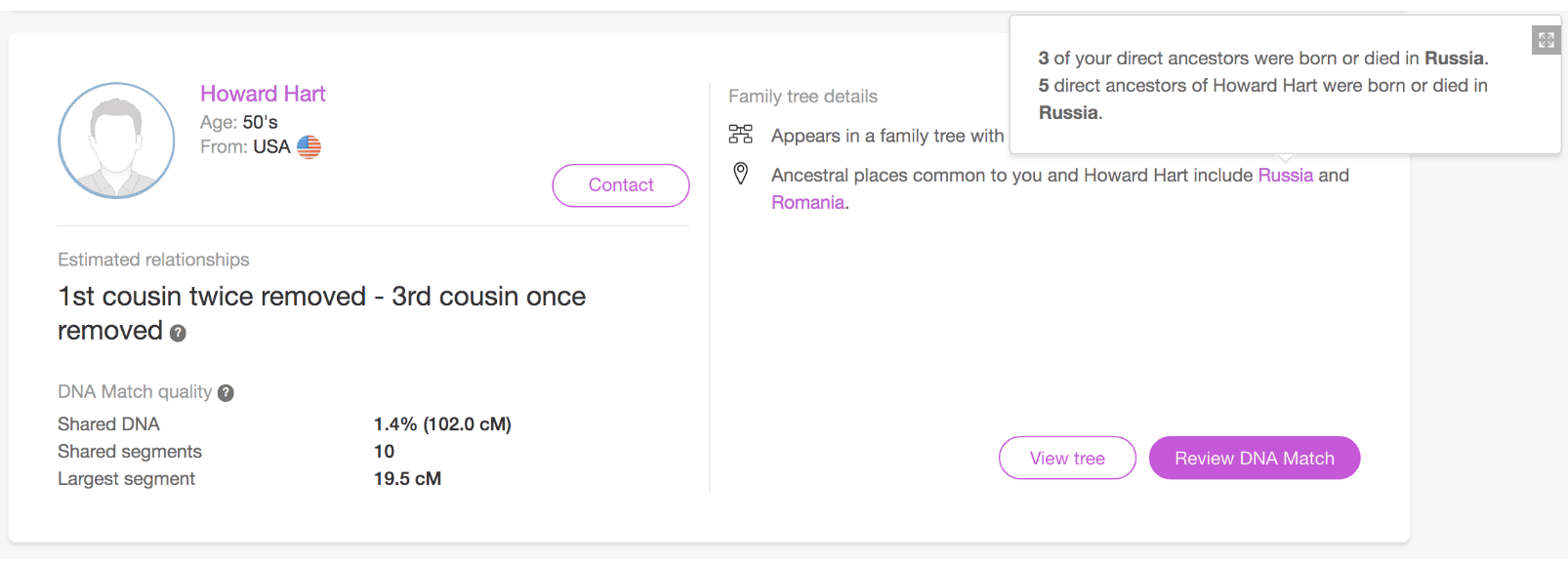
Image from MyHeritage DNA
Click on the Review DNA Match button to see more detailed information about your match. If you and your match have Shared Ancestral Places, this section will show the Ancestral Places you have in common. The map will have pins indicating the cities in which the events took place and below the map, all events in that location from your family tree will be listed side by side with your match’s family tree events. Light gray pins on the map portray events in your family tree, dark gray pins show events in the tree of your DNA Match, and purple pins are used to denote shared places where there are events in both trees that occurred in that specific place.

Image from MyHeritage
Filtering Shared Ancestral Places
Filtering your matches is an indespensible tool, and now at MyHeritage, you can filter your results to show Shared Ancestral Places. Simply use the first entry on the Filter toolbar, which is Tree details, and select “Has shared place.” Isolating the DNA Matches that have Shared Ancestral Places may allow you to figure out how they are related to you.

Image from MyHeritage
This filter can be combined with other multiple filters, to filter matches by additional criteria, and it can also be combined with sorting and search options.
Cost
According to MyHeritage: “Some sections on the Review Match page, such as the new Shared Ancestral Places feature, require a family site subscription to view them in their entirety. Users with a Premium, PremiumPlus, or Complete subscription will have full access to all sections on the Review Match page, while Basic users will have a partial view of some advanced features. Learn more about our subscription plans here.”
Get started with MyHeritage DNA
To take advantage of the Shared Ancestral Places feature, as well as MyHeritage’s robust offering of matches and analysis, pick up a MyHeritage DNA test. They offer one of the most competitive prices on the market, and their powerful matching algorithms can unlock mysteries in your family tree. If you’ve already tested with another testing company, you can also upload your results to MyHeritage! It’s currently a free service, but only for a limited time. So get your results in now to be grandfathered in and receive access to their amazing tools.
Lacey has been working with Genealogy Gems since the company’s inception in 2007. Now, as the full-time manager of Genealogy Gems, she creates the free weekly newsletter, writes blogs, coordinates live events, and collaborates on new product development. No stranger to working with dead people, Lacey holds a degree in Forensic Anthropology, and is passionate about criminal justice and investigative techniques. She is the proud dog mom of Renly the corgi.
Disclosure: This article contains affiliate links and Genealogy Gems will be compensated if you make a purchase after clicking on these links (at no additional cost to you). Thank you for supporting Genealogy Gems!
by Lacey Cooke | Aug 15, 2018 | 01 What's New, DNA, MyHeritage |
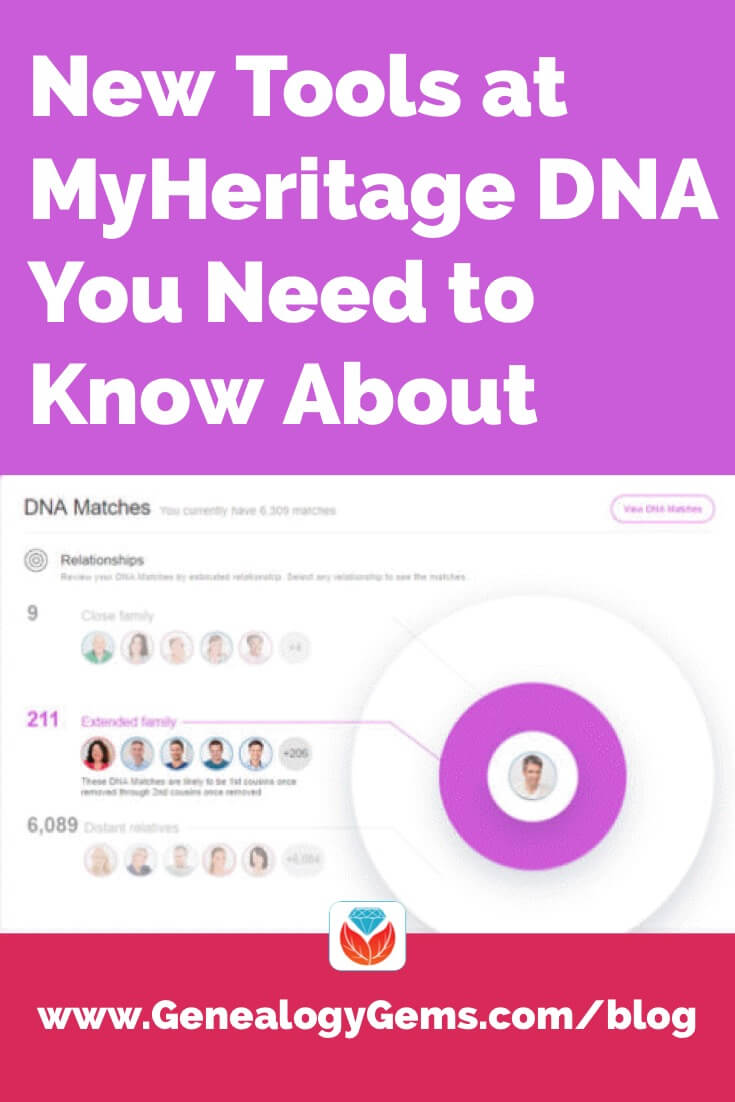 You’ve taken your DNA test for genealogy and anxiously waited for your results. When they arrive, you dive into the ethnicity pie chart. Then matches start rolling in and it can become a little overwhelming to make sense of it all and the benefit it can provide to your genealogy.
You’ve taken your DNA test for genealogy and anxiously waited for your results. When they arrive, you dive into the ethnicity pie chart. Then matches start rolling in and it can become a little overwhelming to make sense of it all and the benefit it can provide to your genealogy.
Thankfully the DNA testing companies are not only focused on advances in testing, but also in creating tools that make it easier for you to interpret and use your results.
MyHeritage DNA continues to release improvements to their DNA product that are meant to both enhance our experience with their website and make it easier to do our genetic genealogy work. You’ll also find an improved presentation of your genetic information that makes it easier to share with your relatives.
The MyHeritage DNA Overview Tab
Just recently MyHeritage DNA announced the addition of new filters for their match page and a bit of a redesign. The small redesign includes moving the ethnicity estimate into a tab right next to the DNA matches tab, as well as adding an Overview tab.
For any relatives who you have convinced to test, but who only show a passing interest in the actual genetic genealogy research, this Overview tab is a great way to show them their results without overwhelming them. There is a simple rundown of the ethnicity results, and then matches are broken up by relationship level and location.
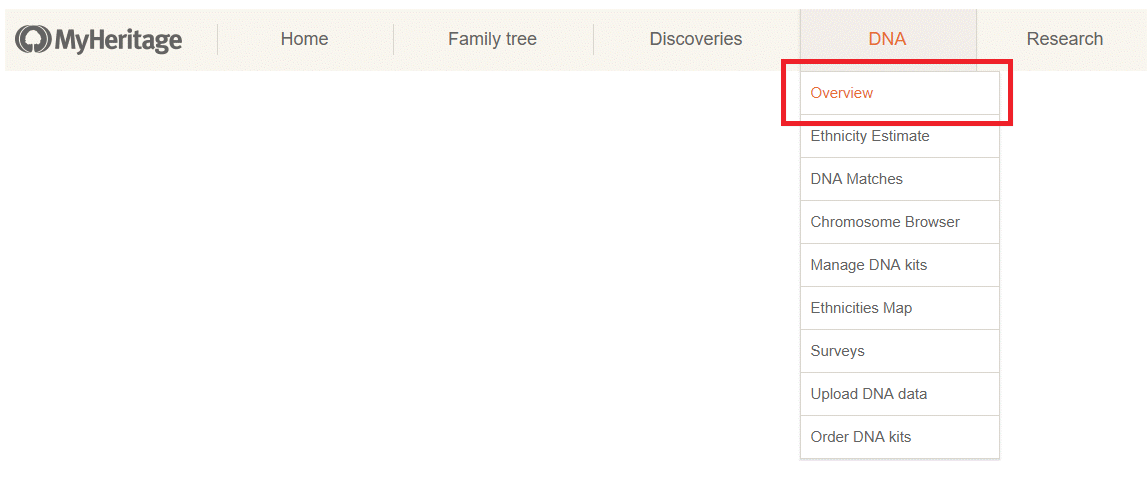
The MyHeritage DNA Location Feature
It is this location feature that will most interest the casual investigator, as well as the serious researcher. This filter lets you see the current location (note: NOT the birth location, though according to the MyHeritage blog post they plan to add birth location in a future update) of your DNA matches. Now, of course, this isn’t an active GPS that is spying on your match, but this tool relies on the location that your match has listed as their location in their MyHeritage account.
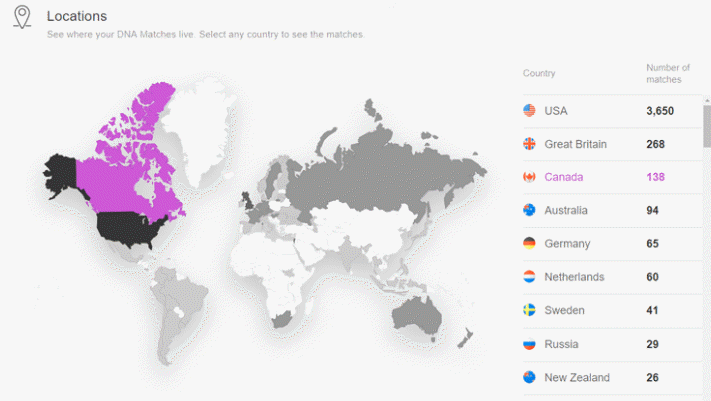
First, it is interesting just to scroll through all of the listed countries and see the variety of locations where your DNA is currently residing. Just think about that for a second: If you are DNA matching with someone in Germany, that means that you are sharing some exact pieces of DNA with someone in Germany and a little bit of you is actually there. This can make for a fascinating exercise when you compare this list of match locations to the locations listed in your ethnicity results. Remember that your ethnicity results can represent your ancestral locations recently, or a very long time ago. So if you see locations on your match list that also appear in your ethnicity results, this might be a good indication that the overlapping location might actually belong in your genealogy. Or the absence of overlap might help you weed out those ethnicities that were thousands of years ago. For example, if you see that your ethnicity results list you as 2% Greek, but you don’t have any DNA matches in Greece, this could mean that your connection to this location is before genealogical time. Of course, it could also mean that the right people from Greece haven’t tested yet, so don’t get too caught up in these deductions.
“If you are DNA matching with someone in Germany,
that means that you are sharing some exact pieces of DNA with someone in Germany
and a little bit of you, is actually there.”
MyHeritage DNA Ethnicities
The last section in the Overview, and the last filter for your match list, shows you how many of your matches are reporting at least 10% of various ethnicities. This might be helpful if you are working your Irish lines, as you can click on Irish, Scottish, and Welsh and see all of your DNA matches who report at least 10% in the Irish, Scottish, and Welsh category.
Combining MyHeritage DNA Filters
Another powerful way to use the filters at MyHeritage is to combine them. On the main match page, you can click on two different filters to further refine your results. So perhaps if you are looking for your Irish ancestor, you might click on the Irish location filter, and then also on the Irish, Scottish, and Welsh ethnicity filter. This will give you all your matches who currently live in Ireland, and who score at least 10% in the Irish, Scottish, and Welsh category.
Of course, the matches that show up after all the filtering aren’t necessarily worth your time or attention. Begin by taking a quick look at how much shared DNA you have. You will want to be sure that you share at least 20 cM before you go spending too much time scouring their pedigree charts for evidence of a shared ancestor.
Likely these filters will continue to improve over time. One thing I would like to see is the ability to use the relationship filter to isolate third cousins, instead of always lumping them with the distant cousins. Most of us don’t have very mysteries in the Extended Family (1st cousins once removed – 2nd cousins once removed) category, so I personally don’t find this filter to be very useful. I would like to see them allow us to filter our best third and fourth cousins out from the rest of our distant matches. Hopefully, MyHeritage can make some refinements in those categories, and thereby make their powerful idea of a two-pronged filter even more effective.
Stay tuned to the Genealogy Gems blog where you will hear updates about MyHeritage DNA (and other DNA testing companies) as they are announced. If you want help in getting more from your DNA test results and using the powerful tools at MyHeritage, my new quick reference guide MyHeritage DNA is available alone or bundled with other DNA resources at the Genealogy Gems store here. Premium eLearning Members can watch the Premium Video Get the Most our of MyHeritage DNA (and download the exclusive handout!) in the Premium Video section here at Genealogy Gems (subscription and sign in required).
What’s your experience using these tools at MyHeritage DNA? Please join the conversation and leave a comment below.
About the Author: Diahan Southard has worked with the Sorenson Molecular Genealogy Foundation, and has been in the genetic genealogy industry since it has been an industry. She holds a degree in Microbiology and her creative side helps her break the science up into delicious bite-sized pieces for you. She’s the author of a full series of DNA guides for genealogists.
Disclosure: This article contains affiliate links and Genealogy Gems will be compensated if you make a purchase after clicking on these links (at no additional cost to you). Thank you for supporting Genealogy Gems!
by Lisa Cooke | Jul 19, 2018 | 01 What's New, DNA |
Here’s exciting genetic genealogy news that you’ll want to know about.
Findmypast and Living DNA have announced a new partnership. The two leading British companies are creating a new DNA experience focused on uncovering British & Irish roots.
This new service will be launched in the Fall of 2018. You can purchase a Living DNA kit right now to get your detailed ethnicity results, interactive map of your heritage throughout history, and family line ancestry (including mother line, and father line for males). As their database grows, your results will automatically be updated to reflect even more accurate results. According to Findmypast, when the Findmypast integration is officially launched later this year, all existing Living DNA test takers will be given the option to opt-in to receive DNA matching at no extra cost. Stay tuned to Genealogy Gems for more official announcements and updates!
From the press release issued by Findmypast:
Thursday July 19th: Leading British and Irish family history website, Findmypast, has today announced a new partnership with the providers of the world’s most advanced DNA test, Living DNA.
Together, the two British companies are creating a new DNA experience that is designed to help customers explore their British and Irish roots. This new experience will combine cutting-edge science with traditional family history research methods, allowing families to discover more about their past and present.
Living DNA’s tests provide a unique breakdown of ethnic identities associated with 21 regions across Britain and Ireland by analyzing unique combinations of linked DNA. This proprietary method delivers a level of detail that is currently unmatched by any other test available on the market.
By combining technology from the leading British DNA company with deep expertise and Findmypast’s vast collection of more 9 billion historical records and newspaper articles, family historian’s will be able to make new discoveries about their British & Irish genetic history.
New, co-branded kits will be launched when the integrated Findmypast and Living DNA service is introduced later in the year.
“Our partnership with Findmypast continues Living DNA’s mission to make DNA testing simple. We are passionate at not only providing cutting edge ways of looking at your DNA but to do so with strict privacy measures by never selling your data. This partnership allows the most precise DNA test on the market to work together with Findmypast’s family history records in a way not done before” says Living DNA Co-Founder, David Nicholson.
Tamsin Todd, CEO of Findmypast, said: “As the world leader for British and Irish records, we work hard every day to help our customers feel the thrill of making discoveries about their families. I’m delighted that we are partnering with a British company, Living DNA, who are pioneers in DNA technology, and look forward to combining our expertise in DNA technology and historical records to help people around the world connect with their British and Irish roots.”
Disclosure: This article contains affiliate links and Genealogy Gems will be compensated if you make a purchase after clicking on these links (at no additional cost to you). Thank you for supporting Genealogy Gems!
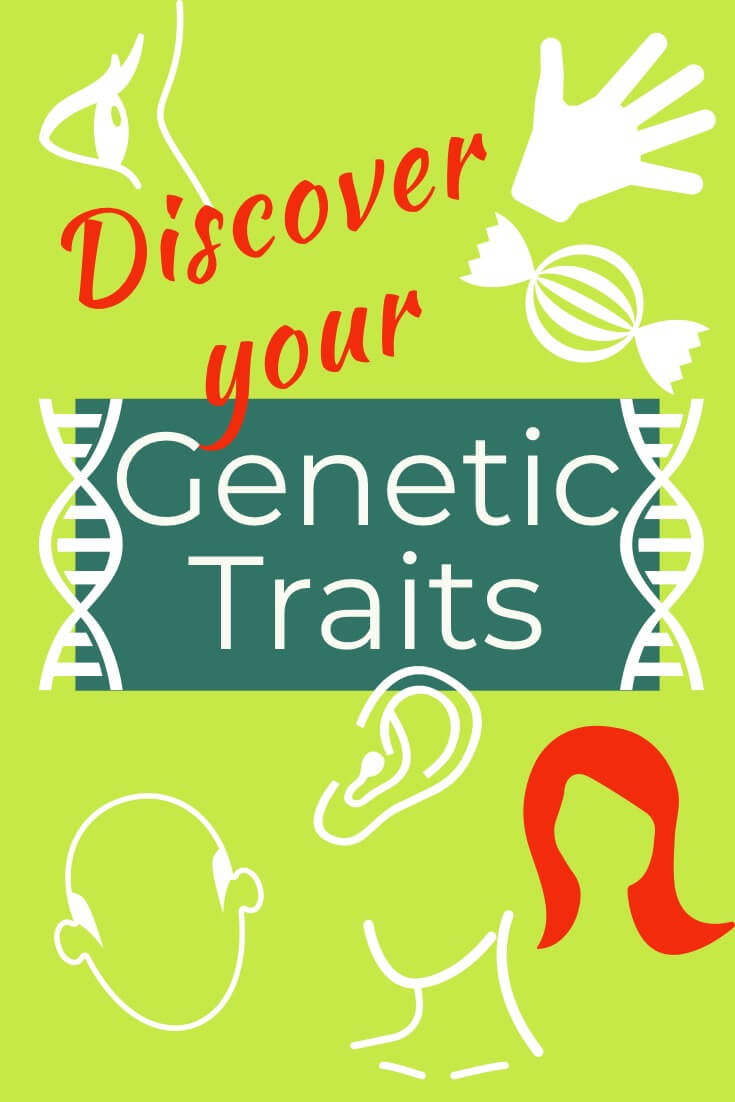
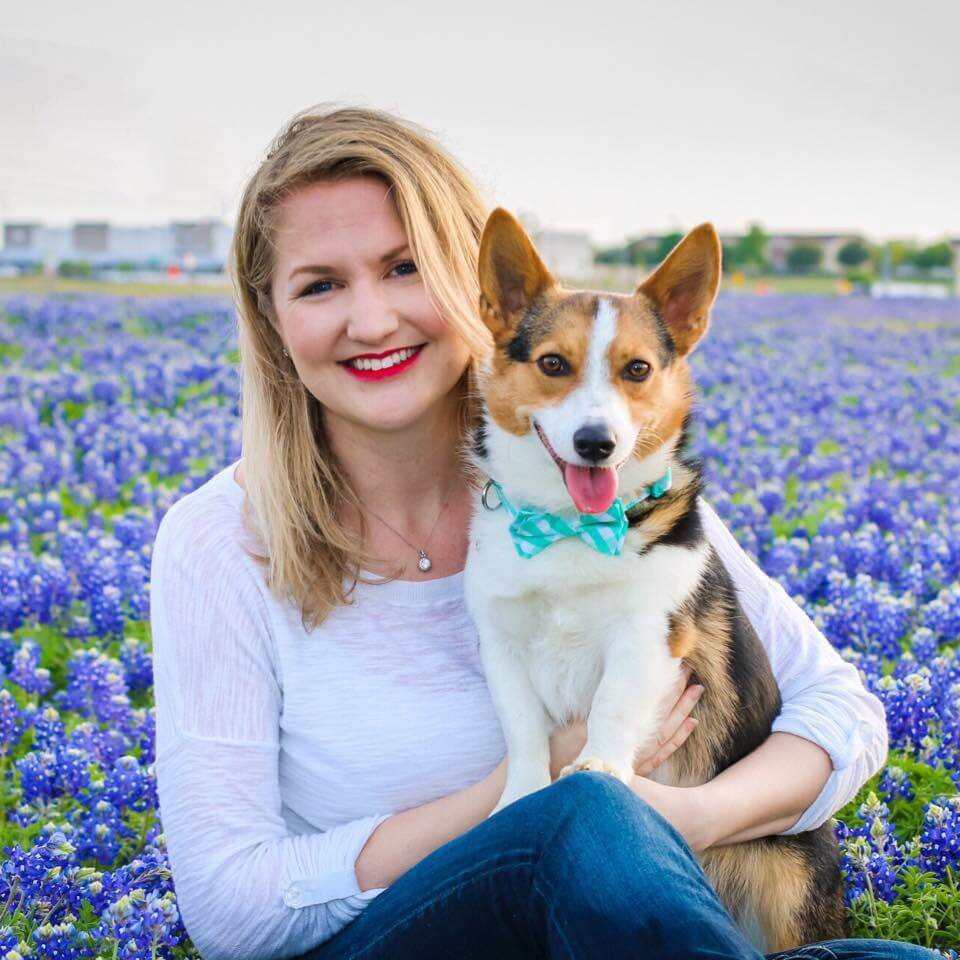


 Genealogy testing companies have been hard at work recalibrating your ethnicity calculations based on new and better data. Here’s the latest from Your DNA Guide Diahan Southard.
Genealogy testing companies have been hard at work recalibrating your ethnicity calculations based on new and better data. Here’s the latest from Your DNA Guide Diahan Southard. 



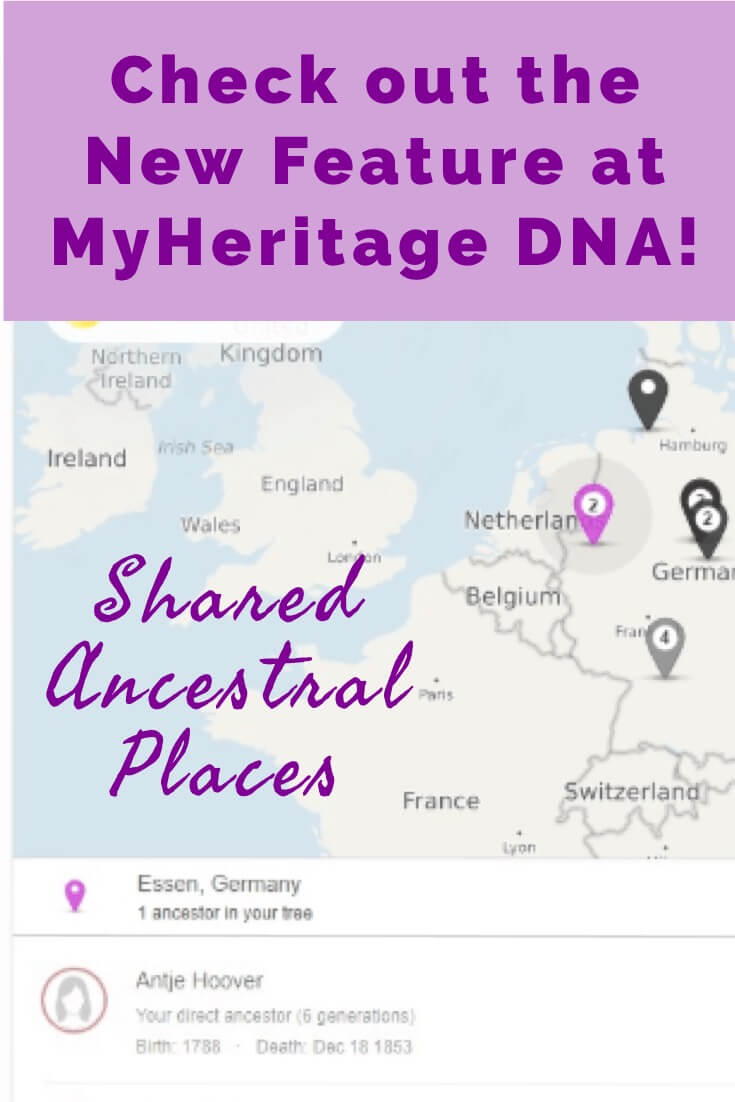



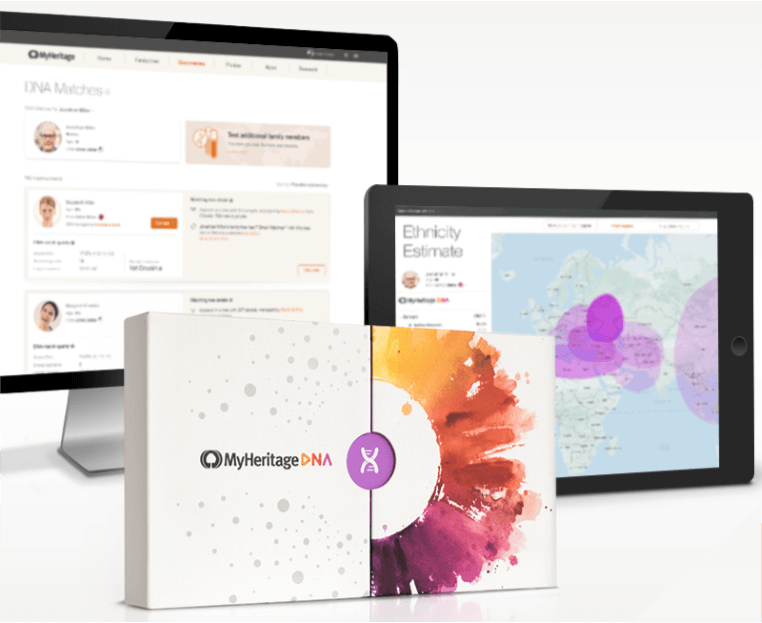
 You’ve taken your DNA test for genealogy and anxiously waited for your results. When they arrive, you dive into the ethnicity pie chart. Then matches start rolling in and it can become a little overwhelming to make sense of it all and the benefit it can provide to your genealogy.
You’ve taken your DNA test for genealogy and anxiously waited for your results. When they arrive, you dive into the ethnicity pie chart. Then matches start rolling in and it can become a little overwhelming to make sense of it all and the benefit it can provide to your genealogy.


